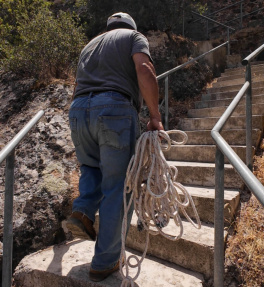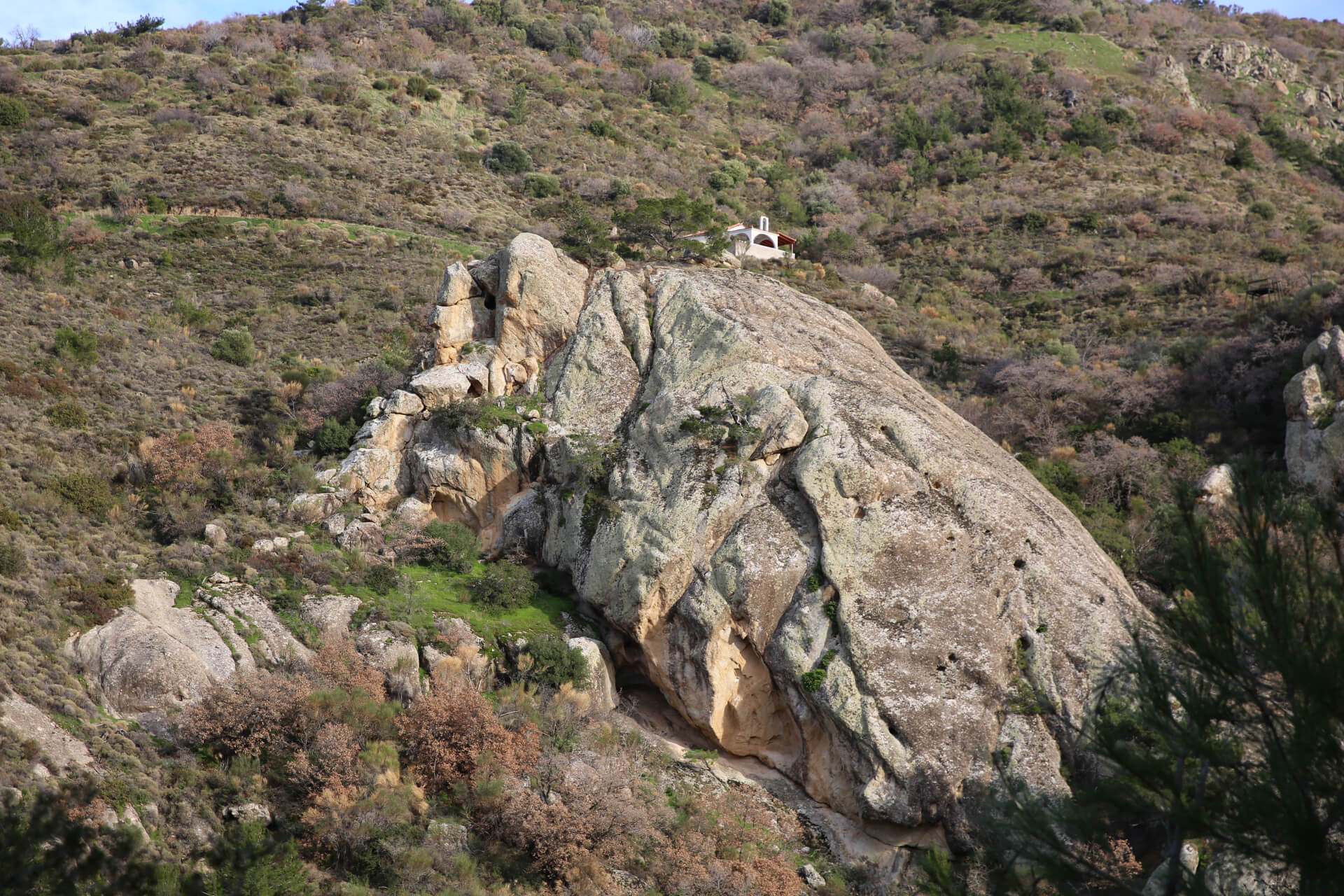STORIES, MYTHS AND LEGENDS
FROM THE VOLCANIC BOULDERS OF KAMPIA
Αbout twenty years ago, at the village café, a local from Kampia, with a look of surprise on his face, asked me, ‘How do you know about “Royal Hole”?’ Little did he know he was talking to the son of a former Kampia schoolteacher. My father, Alexandros Kakaris, taught at Kampia’s school between 1962 and 1965. He was the one who first told me about the hollow in the large boulder north of the village, with its intriguing name and the fascinating story behind it
My father, a young teacher at the time, went to “Royal Hole” once with some locals, about 60 years ago. ‘You can’t see “Royal Hole” right away. You have to take a step over the edge of the cliff, and then you’ll spot it,’ he had told me, warning me about the dangers of getting there. ‘It’s just big enough for a person to squeeze inside. It’s shaped like an eggshell. The stone is untouched, not carved. At the base, opposite the entrance, there’s a stone where the king used to sit.’
Another educator, Minas Kaloudis, who hails from Kampia, mentions that the most impressive boulder standing above the Kampia stream was named “Royal Stone” because of “Royal Hole”. He adds that the king’s hideout ‘can fit about ten people. It’s hard to get inside. The entrance is narrow, and you have to suck in your stomach to squeeze through, lying sideways, not facing forward. As you approach “Royal Hole”, you also have to be careful not to fall into the stream below and get smashed to pieces.’ He further explains that ‘the king was safe inside and would fight off enemies with long wooden spears, knocking them down the cliff.’ This claim may be impossible to prove today, but it sounds entirely believable when you consider the nearby Genoese “Castle of Oria” and the accounts of pirate raids in the area.
Αbout twenty years ago, at the village café, a local from Kampia, with a look of surprise on his face, asked me, ‘How do you know about “Royal Hole”?’ Little did he know he was talking to the son of a former Kampia schoolteacher. My father, Alexandros Kakaris, taught at Kampia’s school between 1962 and 1965. He was the one who first told me about the hollow in the large boulder north of the village, with its intriguing name and the fascinating story behind it
My father, a young teacher at the time, went to “Royal Hole” once with some locals, about 60 years ago. ‘You can’t see “Royal Hole” right away. You have to take a step over the edge of the cliff, and then you’ll spot it,’ he had told me, warning me about the dangers of getting there. ‘It’s just big enough for a person to squeeze inside. It’s shaped like an eggshell. The stone is untouched, not carved. At the base, opposite the entrance, there’s a stone where the king used to sit.’
Another educator, Minas Kaloudis, who hails from Kampia, mentions that the most impressive boulder standing above the Kampia stream was named “Royal Stone” because of “Royal Hole”. He adds that the king’s hideout ‘can fit about ten people. It’s hard to get inside. The entrance is narrow, and you have to suck in your stomach to squeeze through, lying sideways, not facing forward. As you approach “Royal Hole”, you also have to be careful not to fall into the stream below and get smashed to pieces.’ He further explains that ‘the king was safe inside and would fight off enemies with long wooden spears, knocking them down the cliff.’ This claim may be impossible to prove today, but it sounds entirely believable when you consider the nearby Genoese “Castle of Oria” and the accounts of pirate raids in the area.

📷 Antonis Tsatsaronis in the Kampia ravine.

📷 Teacher Alexandros Kakaris on the right, at the inauguration of the Chalandra School fountain.

📷 Giannis Tsoukalas going up towards the “Castle of Oria”.
A few years ago, I made my first, unsuccessful attempt to find it. This year, I made two more quick trips to “Royal Hole”, taking advantage of our visits to Kampia to hike the beautiful trail. On one of those hikes, we met the well-known nature lover, Antonis Tsatsaronis, in the lush valley. ‘Antonis, do you happen to know where “Royal Hole” is?’ I asked him, pointing towards the imposing rocks towering above us. ‘How would I know? That whole area is full of holes,’ he replied, and he wasn’t wrong.
This rock is one of the many volcanic formations that surface along the Kampia stream. It is a rhyolite, a rock formed about 14 million years ago through complex geological processes that led to the creation of volcanoes, both on Chios and in neighboring areas. Geologist and geo-environmentalist Vasiliki Barsaki points out, ‘The rock is highly fractured and altered, with impressive geomorphological features created by underground and surface cavities, sparking human imagination and giving rise to myths and local legends.
A few years ago, I made my first, unsuccessful attempt to find it. This year, I made two more quick trips to “Royal Hole”, taking advantage of our visits to Kampia to hike the beautiful trail. On one of those hikes, we met the well-known nature lover, Antonis Tsatsaronis, in the lush valley. ‘Antonis, do you happen to know where “Royal Hole” is?’ I asked him, pointing towards the imposing rocks towering above us. ‘How would I know? That whole area is full of holes,’ he replied, and he wasn’t wrong.
This rock is one of the many volcanic formations that surface along the Kampia stream. It is a rhyolite, a rock formed about 14 million years ago through complex geological processes that led to the creation of volcanoes, both on Chios and in neighboring areas. Geologist and geo-environmentalist Vasiliki Barsaki points out, ‘The rock is highly fractured and altered, with impressive geomorphological features created by underground and surface cavities, sparking human imagination and giving rise to myths and local legends.

📷 The “Royal Hole”. To the left, you can also see “The Beast”.
‘Near Kampia, within a valley opening toward the sea, there is a small medieval castle perched on a steep rocky hill. Opposite it stands another rocky height, similarly fortified, on which there is a small church of Saint Paraskevi,’ writes Georgios Zolotas. He adds, ‘The surrounding villagers say that beneath the small fortress lived a dragon, according to some, or a fearsome monster, according to others, which Saint Paraskevi turned to stone. On the sides of the dragon’s rock, there is a large cave known as the “Devil’s Hole”.’ Today, the few villagers still call that rock “The Beast”, but they claim to know nothing of the “Devil’s Hole”. According to Kaloudis, there is a fossil of a gigantic worm on “Τhe Beast”, and legend says that the Virgin Mary killed it, saving the villagers’ crops from destruction.
‘Near Kampia, within a valley opening toward the sea, there is a small medieval castle perched on a steep rocky hill. Opposite it stands another rocky height, similarly fortified, on which there is a small church of Saint Paraskevi,’ writes Georgios Zolotas. He adds, ‘The surrounding villagers say that beneath the small fortress lived a dragon, according to some, or a fearsome monster, according to others, which Saint Paraskevi turned to stone. On the sides of the dragon’s rock, there is a large cave known as the “Devil’s Hole”.’ Today, the few villagers still call that rock “The Beast”, but they claim to know nothing of the “Devil’s Hole”. According to Kaloudis, there is a fossil of a gigantic worm on “Τhe Beast”, and legend says that the Virgin Mary killed it, saving the villagers’ crops from destruction.

📷“The Beast”. In the background, you can also see the chapel of the Virgin Mary.
At the end of June, I was led to “Royal Hole” by the very kind Giannis Tsoukalas, a former student of my father and now the village coffee shop owner. ‘It’s like an oven. We used to go there when we were kids. I haven’t been since ‘77. I once took an American, but I didn’t go in. I just got close.’ The same happened this time. We went together up to a certain point, and he showed me where I needed to climb down to find it. There’s no trail. Some bushes get in the way, while others help you move along. I climbed down lower. I was 2 or 3 meters away from the crack but still couldn’t see it, until I made that step my father had told me about, and then Vasilotrypa appeared right next to me.
I step inside. The interior does indeed resemble an oven. It has an oval shape, with smooth walls in soft colors. There’s no sign of cave decoration. The king’s stone seat is gone. In its place, there’s a bit of dirt, and near the entrance, there are two beetles. No other signs of life, no birds or bats. I notice some moisture in a few spots on the ceiling and a few ‘worrying’ cracks in the rock.
At the end of June, I was led to “Royal Hole” by the very kind Giannis Tsoukalas, a former student of my father and now the village coffee shop owner. ‘It’s like an oven. We used to go there when we were kids. I haven’t been since ‘77. I once took an American, but I didn’t go in. I just got close.’ The same happened this time. We went together up to a certain point, and he showed me where I needed to climb down to find it. There’s no trail. Some bushes get in the way, while others help you move along. I climbed down lower. I was 2 or 3 meters away from the crack but still couldn’t see it, until I made that step my father had told me about, and then Vasilotrypa appeared right next to me.
I step inside. The interior does indeed resemble an oven. It has an oval shape, with smooth walls in soft colors. There’s no sign of cave decoration. The king’s stone seat is gone. In its place, there’s a bit of dirt, and near the entrance, there are two beetles. No other signs of life, no birds or bats. I notice some moisture in a few spots on the ceiling and a few ‘worrying’ cracks in the rock.

📷 The crack-entrance to the “Royal Hole”.

📷 The interior of the “Royal Hole”.
I savor the moments inside Vasilotrypa. A strange feeling of familiarity, calm, and mystery overwhelms me. I take photos. Giannis also asks me to take some with his phone. It’s time to leave. The return is more challenging and requires caution. But I’m happy. Dad, I finally found “Royal Hole”.
I savor the moments inside Vasilotrypa. A strange feeling of familiarity, calm, and mystery overwhelms me. I take photos. Giannis also asks me to take some with his phone. It’s time to leave. The return is more challenging and requires caution. But I’m happy. Dad, I finally found “Royal Hole”.